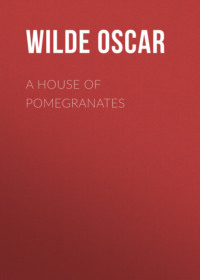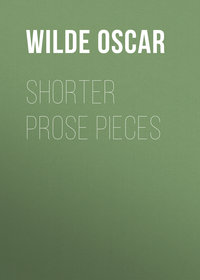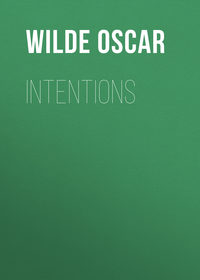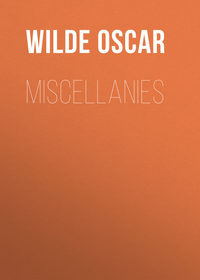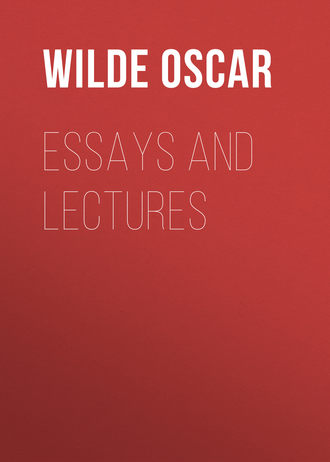 полная версия
полная версияEssays and Lectures
Shelley felt how incomplete our movement was in this respect, and has shown in one great tragedy by what terror and pity he would have purified our age; but in spite of The Cenci the drama is one of the artistic forms through which the genius of the England of this century seeks in vain to find outlet and expression. He has had no worthy imitators.
It is rather, perhaps, to you that we should turn to complete and perfect this great movement of ours, for there is something Hellenic in your air and world, something that has a quicker breath of the joy and power of Elizabeth’s England about it than our ancient civilisation can give us. For you, at least, are young; ‘no hungry generations tread you down,’ and the past does not weary you with the intolerable burden of its memories nor mock you with the ruins of a beauty, the secret of whose creation you have lost. That very absence of tradition, which Mr. Ruskin thought would rob your rivers of their laughter and your flowers of their light, may be rather the source of your freedom and your strength.
To speak in literature with the perfect rectitude and insouciance of the movements of animals, and the unimpeachableness of the sentiment of trees in the woods and grass by the roadside, has been defined by one of your poets as a flawless triumph of art. It is a triumph which you above all nations may be destined to achieve. For the voices that have their dwelling in sea and mountain are not the chosen music of Liberty only; other messages are there in the wonder of wind-swept height and the majesty of silent deep – messages that, if you will but listen to them, may yield you the splendour of some new imagination, the marvel of some new beauty.
‘I foresee,’ said Goethe, ‘the dawn of a new literature which all people may claim as their own, for all have contributed to its foundation.’ If, then, this is so, and if the materials for a civilisation as great as that of Europe lie all around you, what profit, you will ask me, will all this study of our poets and painters be to you? I might answer that the intellect can be engaged without direct didactic object on an artistic and historical problem; that the demand of the intellect is merely to feel itself alive; that nothing which has ever interested men or women can cease to be a fit subject for culture.
I might remind you of what all Europe owes to the sorrow of a single Florentine in exile at Verona, or to the love of Petrarch by that little well in Southern France; nay, more, how even in this dull, materialistic age the simple expression of an old man’s simple life, passed away from the clamour of great cities amid the lakes and misty hills of Cumberland, has opened out for England treasures of new joy compared with which the treasures of her luxury are as barren as the sea which she has made her highway, and as bitter as the fire which she would make her slave.
But I think it will bring you something besides this, something that is the knowledge of real strength in art: not that you should imitate the works of these men; but their artistic spirit, their artistic attitude, I think you should absorb that.
For in nations, as in individuals, if the passion for creation be not accompanied by the critical, the æsthetic faculty also, it will be sure to waste its strength aimlessly, failing perhaps in the artistic spirit of choice, or in the mistaking of feeling for form, or in the following of false ideals.
For the various spiritual forms of the imagination have a natural affinity with certain sensuous forms of art – and to discern the qualities of each art, to intensify as well its limitations as its powers of expression, is one of the aims that culture sets before us. It is not an increased moral sense, an increased moral supervision that your literature needs. Indeed, one should never talk of a moral or an immoral poem – poems are either well written or badly written, that is all. And, indeed, any element of morals or implied reference to a standard of good or evil in art is often a sign of a certain incompleteness of vision, often a note of discord in the harmony of an imaginative creation; for all good work aims at a purely artistic effect. ‘We must be careful,’ said Goethe, ‘not to be always looking for culture merely in what is obviously moral. Everything that is great promotes civilisation as soon as we are aware of it.’
But, as in your cities so in your literature, it is a permanent canon and standard of taste, an increased sensibility to beauty (if I may say so) that is lacking. All noble work is not national merely, but universal. The political independence of a nation must not be confused with any intellectual isolation. The spiritual freedom, indeed, your own generous lives and liberal air will give you. From us you will learn the classical restraint of form.
For all great art is delicate art, roughness having very little to do with strength, and harshness very little to do with power. ‘The artist,’ as Mr. Swinburne says, ‘must be perfectly articulate.’
This limitation is for the artist perfect freedom: it is at once the origin and the sign of his strength. So that all the supreme masters of style – Dante, Sophocles, Shakespeare – are the supreme masters of spiritual and intellectual vision also.
Love art for its own sake, and then all things that you need will be added to you.
This devotion to beauty and to the creation of beautiful things is the test of all great civilised nations. Philosophy may teach us to bear with equanimity the misfortunes of our neighbours, and science resolve the moral sense into a secretion of sugar, but art is what makes the life of each citizen a sacrament and not a speculation, art is what makes the life of the whole race immortal.
For beauty is the only thing that time cannot harm. Philosophies fall away like sand, and creeds follow one another like the withered leaves of autumn; but what is beautiful is a joy for all seasons and a possession for all eternity.
Wars and the clash of armies and the meeting of men in battle by trampled field or leaguered city, and the rising of nations there must always be. But I think that art, by creating a common intellectual atmosphere between all countries, might – if it could not overshadow the world with the silver wings of peace – at least make men such brothers that they would not go out to slay one another for the whim or folly of some king or minister, as they do in Europe. Fraternity would come no more with the hands of Cain, nor Liberty betray freedom with the kiss of Anarchy; for national hatreds are always strongest where culture is lowest.
‘How could I?’ said Goethe, when reproached for not writing like Korner against the French. ‘How could I, to whom barbarism and culture alone are of importance, hate a nation which is among the most cultivated of the earth, a nation to which I owe a great part of my own cultivation?’
Mighty empires, too, there must always be as long as personal ambition and the spirit of the age are one, but art at least is the only empire which a nation’s enemies cannot take from her by conquest, but which is taken by submission only. The sovereignty of Greece and Rome is not yet passed away, though the gods of the one be dead and the eagles of the other tired.
And we in our Renaissance are seeking to create a sovereignty that will still be England’s when her yellow leopards have grown weary of wars and the rose of her shield is crimsoned no more with the blood of battle; and you, too, absorbing into the generous heart of a great people this pervading artistic spirit, will create for yourselves such riches as you have never yet created, though your land be a network of railways and your cities the harbours for the galleys of the world.
I know, indeed, that the divine natural prescience of beauty which is the inalienable inheritance of Greek and Italian is not our inheritance. For such an informing and presiding spirit of art to shield us from all harsh and alien influences, we of the Northern races must turn rather to that strained self-consciousness of our age which, as it is the key-note of all our romantic art, must be the source of all or nearly all our culture. I mean that intellectual curiosity of the nineteenth century which is always looking for the secret of the life that still lingers round old and bygone forms of culture. It takes from each what is serviceable for the modern spirit – from Athens its wonder without its worship, from Venice its splendour without its sin. The same spirit is always analysing its own strength and its own weakness, counting what it owes to East and to West, to the olive-trees of Colonus and to the palm-trees of Lebanon, to Gethsemane and to the garden of Proserpine.
And yet the truths of art cannot be taught: they are revealed only, revealed to natures which have made themselves receptive of all beautiful impressions by the study and worship of all beautiful things. And hence the enormous importance given to the decorative arts in our English Renaissance; hence all that marvel of design that comes from the hand of Edward Burne-Jones, all that weaving of tapestry and staining of glass, that beautiful working in clay and metal and wood which we owe to William Morris, the greatest handicraftsman we have had in England since the fourteenth century.
So, in years to come there will be nothing in any man’s house which has not given delight to its maker and does not give delight to its user. The children, like the children of Plato’s perfect city, will grow up ‘in a simple atmosphere of all fair things’ – I quote from the passage in the Republic– ‘a simple atmosphere of all fair things, where beauty, which is the spirit of art, will come on eye and ear like a fresh breath of wind that brings health from a clear upland, and insensibly and gradually draw the child’s soul into harmony with all knowledge and all wisdom, so that he will love what is beautiful and good, and hate what is evil and ugly (for they always go together) long before he knows the reason why; and then when reason comes will kiss her on the cheek as a friend.’
That is what Plato thought decorative art could do for a nation, feeling that the secret not of philosophy merely but of all gracious existence might be externally hidden from any one whose youth had been passed in uncomely and vulgar surroundings, and that the beauty of form and colour even, as he says, in the meanest vessels of the house, will find its way into the inmost places of the soul and lead the boy naturally to look for that divine harmony of spiritual life of which art was to him the material symbol and warrant.
Prelude indeed to all knowledge and all wisdom will this love of beautiful things be for us; yet there are times when wisdom becomes a burden and knowledge is one with sorrow: for as every body has its shadow so every soul has its scepticism. In such dread moments of discord and despair where should we, of this torn and troubled age, turn our steps if not to that secure house of beauty where there is always a little forgetfulness, always a great joy; to that città divina, as the old Italian heresy called it, the divine city where one can stand, though only for a brief moment, apart from the division and terror of the world and the choice of the world too?
This is that consolation des arts which is the key-note of Gautier’s poetry, the secret of modern life foreshadowed – as indeed what in our century is not? – by Goethe. You remember what he said to the German people: ‘Only have the courage,’ he said, ‘to give yourselves up to your impressions, allow yourselves to be delighted, moved, elevated, nay instructed, inspired for something great.’ The courage to give yourselves up to your impressions: yes, that is the secret of the artistic life – for while art has been defined as an escape from the tyranny of the senses, it is an escape rather from the tyranny of the soul. But only to those who worship her above all things does she ever reveal her true treasure: else will she be as powerless to aid you as the mutilated Venus of the Louvre was before the romantic but sceptical nature of Heine.
And indeed I think it would be impossible to overrate the gain that might follow if we had about us only what gave pleasure to the maker of it and gives pleasure to its user, that being the simplest of all rules about decoration. One thing, at least, I think it would do for us: there is no surer test of a great country than how near it stands to its own poets; but between the singers of our day and the workers to whom they would sing there seems to be an ever-widening and dividing chasm, a chasm which slander and mockery cannot traverse, but which is spanned by the luminous wings of love.
And of such love I think that the abiding presence in our houses of noble imaginative work would be the surest seed and preparation. I do not mean merely as regards that direct literary expression of art by which, from the little red-and-black cruse of oil or wine, a Greek boy could learn of the lionlike splendour of Achilles, of the strength of Hector and the beauty of Paris and the wonder of Helen, long before he stood and listened in crowded market-place or in theatre of marble; or by which an Italian child of the fifteenth century could know of the chastity of Lucrece and the death of Camilla from carven doorway and from painted chest. For the good we get from art is not what we learn from it; it is what we become through it. Its real influence will be in giving the mind that enthusiasm which is the secret of Hellenism, accustoming it to demand from art all that art can do in rearranging the facts of common life for us – whether it be by giving the most spiritual interpretation of one’s own moments of highest passion or the most sensuous expression of those thoughts that are the farthest removed from sense; in accustoming it to love the things of the imagination for their own sake, and to desire beauty and grace in all things. For he who does not love art in all things does not love it at all, and he who does not need art in all things does not need it at all.
I will not dwell here on what I am sure has delighted you all in our great Gothic cathedrals. I mean how the artist of that time, handicraftsman himself in stone or glass, found the best motives for his art, always ready for his hand and always beautiful, in the daily work of the artificers he saw around him – as in those lovely windows of Chartres – where the dyer dips in the vat and the potter sits at the wheel, and the weaver stands at the loom: real manufacturers these, workers with the hand, and entirely delightful to look at, not like the smug and vapid shopman of our time, who knows nothing of the web or vase he sells, except that he is charging you double its value and thinking you a fool for buying it. Nor can I but just note, in passing, the immense influence the decorative work of Greece and Italy had on its artists, the one teaching the sculptor that restraining influence of design which is the glory of the Parthenon, the other keeping painting always true to its primary, pictorial condition of noble colour which is the secret of the school of Venice; for I wish rather, in this lecture at least, to dwell on the effect that decorative art has on human life – on its social not its purely artistic effect.
There are two kinds of men in the world, two great creeds, two different forms of natures: men to whom the end of life is action, and men to whom the end of life is thought. As regards the latter, who seek for experience itself and not for the fruits of experience, who must burn always with one of the passions of this fiery-coloured world, who find life interesting not for its secret but for its situations, for its pulsations and not for its purpose; the passion for beauty engendered by the decorative arts will be to them more satisfying than any political or religious enthusiasm, any enthusiasm for humanity, any ecstasy or sorrow for love. For art comes to one professing primarily to give nothing but the highest quality to one’s moments, and for those moments’ sake. So far for those to whom the end of life is thought. As regards the others, who hold that life is inseparable from labour, to them should this movement be specially dear: for, if our days are barren without industry, industry without art is barbarism.
Hewers of wood and drawers of water there must be always indeed among us. Our modern machinery has not much lightened the labour of man after all: but at least let the pitcher that stands by the well be beautiful and surely the labour of the day will be lightened: let the wood be made receptive of some lovely form, some gracious design, and there will come no longer discontent but joy to the toiler. For what is decoration but the worker’s expression of joy in his work? And not joy merely – that is a great thing yet not enough – but that opportunity of expressing his own individuality which, as it is the essence of all life, is the source of all art. ‘I have tried,’ I remember William Morris saying to me once, ‘I have tried to make each of my workers an artist, and when I say an artist I mean a man.’ For the worker then, handicraftsman of whatever kind he is, art is no longer to be a purple robe woven by a slave and thrown over the whitened body of a leprous king to hide and to adorn the sin of his luxury, but rather the beautiful and noble expression of a life that has in it something beautiful and noble.
And so you must seek out your workman and give him, as far as possible, the right surroundings, for remember that the real test and virtue of a workman is not his earnestness nor his industry even, but his power of design merely; and that ‘design is not the offspring of idle fancy: it is the studied result of accumulative observation and delightful habit.’ All the teaching in the world is of no avail if you do not surround your workman with happy influences and with beautiful things. It is impossible for him to have right ideas about colour unless he sees the lovely colours of Nature unspoiled; impossible for him to supply beautiful incident and action unless he sees beautiful incident and action in the world about him.
For to cultivate sympathy you must be among living things and thinking about them, and to cultivate admiration you must be among beautiful things and looking at them. ‘The steel of Toledo and the silk of Genoa did but give strength to oppression and lustre to pride,’ as Mr. Ruskin says; let it be for you to create an art that is made by the hands of the people for the joy of the people, to please the hearts of the people, too; an art that will be your expression of your delight in life. There is nothing ‘in common life too mean, in common things too trivial to be ennobled by your touch’; nothing in life that art cannot sanctify.
You have heard, I think, a few of you, of two flowers connected with the æsthetic movement in England, and said (I assure you, erroneously) to be the food of some æsthetic young men. Well, let me tell you that the reason we love the lily and the sunflower, in spite of what Mr. Gilbert may tell you, is not for any vegetable fashion at all. It is because these two lovely flowers are in England the two most perfect models of design, the most naturally adapted for decorative art – the gaudy leonine beauty of the one and the precious loveliness of the other giving to the artist the most entire and perfect joy. And so with you: let there be no flower in your meadows that does not wreathe its tendrils around your pillows, no little leaf in your Titan forests that does not lend its form to design, no curving spray of wild rose or brier that does not live for ever in carven arch or window or marble, no bird in your air that is not giving the iridescent wonder of its colour, the exquisite curves of its wings in flight, to make more precious the preciousness of simple adornment.
We spend our days, each one of us, in looking for the secret of life. Well, the secret of life is in art.
HOUSE DECORATION
A lecture delivered in America during Wilde’s tour in 1882. It was announced as a lecture on ‘The Practical Application of the Principles of Æsthetic Theory to Exterior and Interior House Decoration, With Observations upon Dress and Personal Ornaments.’ The earliest date on which it is known to have been given is May 11, 1882.
In my last lecture I gave you something of the history of Art in England. I sought to trace the influence of the French Revolution upon its development. I said something of the song of Keats and the school of the pre-Raphaelites. But I do not want to shelter the movement, which I have called the English Renaissance, under any palladium however noble, or any name however revered. The roots of it have, indeed, to be sought for in things that have long passed away, and not, as some suppose, in the fancy of a few young men – although I am not altogether sure that there is anything much better than the fancy of a few young men.
When I appeared before you on a previous occasion, I had seen nothing of American art save the Doric columns and Corinthian chimney-pots visible on your Broadway and Fifth Avenue. Since then, I have been through your country to some fifty or sixty different cities, I think. I find that what your people need is not so much high imaginative art but that which hallows the vessels of everyday use. I suppose that the poet will sing and the artist will paint regardless whether the world praises or blames. He has his own world and is independent of his fellow-men. But the handicraftsman is dependent on your pleasure and opinion. He needs your encouragement and he must have beautiful surroundings. Your people love art but do not sufficiently honour the handicraftsman. Of course, those millionaires who can pillage Europe for their pleasure need have no care to encourage such; but I speak for those whose desire for beautiful things is larger than their means. I find that one great trouble all over is that your workmen are not given to noble designs. You cannot be indifferent to this, because Art is not something which you can take or leave. It is a necessity of human life.
And what is the meaning of this beautiful decoration which we call art? In the first place, it means value to the workman and it means the pleasure which he must necessarily take in making a beautiful thing. The mark of all good art is not that the thing done is done exactly or finely, for machinery may do as much, but that it is worked out with the head and the workman’s heart. I cannot impress the point too frequently that beautiful and rational designs are necessary in all work. I did not imagine, until I went into some of your simpler cities, that there was so much bad work done. I found, where I went, bad wall-papers horribly designed, and coloured carpets, and that old offender the horse-hair sofa, whose stolid look of indifference is always so depressing. I found meaningless chandeliers and machine-made furniture, generally of rosewood, which creaked dismally under the weight of the ubiquitous interviewer. I came across the small iron stove which they always persist in decorating with machine-made ornaments, and which is as great a bore as a wet day or any other particularly dreadful institution. When unusual extravagance was indulged in, it was garnished with two funeral urns.
It must always be remembered that what is well and carefully made by an honest workman, after a rational design, increases in beauty and value as the years go on. The old furniture brought over by the Pilgrims, two hundred years ago, which I saw in New England, is just as good and as beautiful to-day as it was when it first came here. Now, what you must do is to bring artists and handicraftsmen together. Handicraftsmen cannot live, certainly cannot thrive, without such companionship. Separate these two and you rob art of all spiritual motive.
Having done this, you must place your workman in the midst of beautiful surroundings. The artist is not dependent on the visible and the tangible. He has his visions and his dreams to feed on. But the workman must see lovely forms as he goes to his work in the morning and returns at eventide. And, in connection with this, I want to assure you that noble and beautiful designs are never the result of idle fancy or purposeless day-dreaming. They come only as the accumulation of habits of long and delightful observation. And yet such things may not be taught. Right ideas concerning them can certainly be obtained only by those who have been accustomed to rooms that are beautiful and colours that are satisfying.


